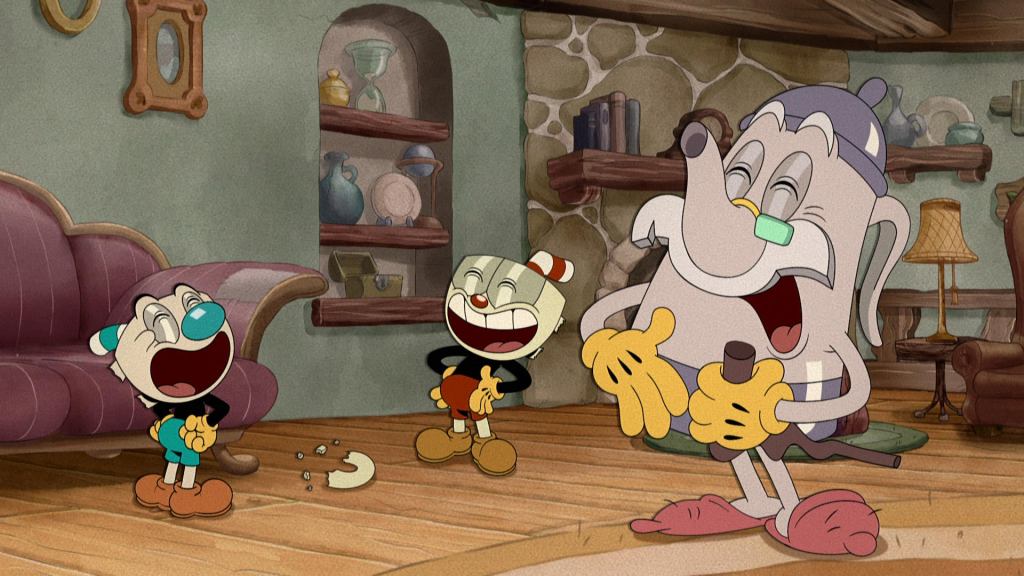The Cuphead Show! is finally coming to Netflix this week and it makes for one of the most unique video game adaptations to date. Not only is this TV series based on the popular 2017 game, but the game in turn is based on old cartoons from the 1930s. As such, for The Cuphead Show! to be adapting the game for TV is almost working backward in a strange sort of way.
Videos by ComicBook.com
Recently, we were able to talk with the show’s creator Dave Wasson and Art Director Andrea Fernandez about what it was like to make The Cuphead Show! with Netflix and the challenges that were involved with creating a series that reflects an animation style of a long-gone age.
Initial Involvement

CB: How did you both get involved with The Cuphead Show!, and what about Cuphead as a video game made you think it would translate easily to the cartoon medium?
Dave Wasson: Easily is probably a debatable word, but I remember hearing about the video game before it came out, and then when I finally saw it, just being blown away by how amazing the animation was and how true they’d stayed to that 1930s rubber hose style. So it was just the quality of the game and the richness, the execution of the movement, and the beautiful backgrounds, all of it. So it was super impressive seeing it, and really inspiring. So at that time, I had no idea that anybody had any thoughts of it being a show, but I remember being really blown away by it as a product.
Andrea Fernandez: I used to watch the play-throughs while I was working on stuff, and just leave it playing, because I loved the music, I loved the look. So I’d just watch it for hours on end on YouTube. Because I just love the vibe of the game. So then I heard Netflix was looking to make the show. Dave was already on it. But I had no idea who was on it, or how much of a reality it was. And then, at some point, somebody gave me the hot tip that Dave was actually producing The Cuphead Show!, and I was just like, “Let me in.”
DW: We didn’t know each other that well, but, yeah, that was how that happened. And I was the first person hired on it. There was kind of an audition process for show-runners, and there were a bunch of people. It was kind of a who’s who of contemporary TV show-runners that auditioned, and somehow I tricked them into letting it be me.
Adapting the Show With Little Source Material
CB: I think the most interesting thing about The Cuphead Show! is that it doesn’t have as much source material to pull from compared to some of these other video game adaptations that we’ve seen lately in TV and film. How did that influence what you decided to do with this series?
DW: Well, the biggest challenge and the biggest joy of doing it was we had this amazing visual smorgasbord of characters to choose from, but none of them had real personalities yet. So I feel like I always say the Moldenhauers dropped these breadcrumbs for us. We knew that the Cups were brothers. We knew that they lived with their Elder Kettle in the woods. And so we wanted to stay true to as much of the mythology that was already there, we wanted to stick with, but we got to create characters, and give them real personalities, and cast the voices. That was super fun to do.
AF: I also think that, like you were saying, a lot of like games come with all this backstory, and with watching how the show was developed, so much of it was the story team in the writer’s room with Dave and Cosmo and our story editor just having a good time, and figuring out who the characters were and what they were doing. It was a lot more about comedy than it was lore. And I think that’s a little different than other projects that come from that video game space. This team was really invested in getting real characters with great comedic performances that were going to bring you through an entire episode without really having to have played the game.
So I think I took that as a springboard, and for me, it was more like, okay, how do I make the vibe of the game come through in the look and the visual, the aesthetics, like all that kind of stuff was more pulled from the game than necessarily some of the story and character stuff that Dave is talking about.
Choosing What to Adapt From the Video Game

CB: How did you decide which parts of Cuphead you directly wanted to incorporate in The Cuphead Show!? There are a few episodes that are directly based on some of the boss fights from the game, but others are completely different. How did you find that balance?
DW: I think we knew we wanted it to be a balance. We wanted it to be all character-driven comedy. So it’s like the comedy comes from the personalities of the characters and like what they all want, what they care about, what they don’t care about, and character traits. Cuphead is cocky, so that causes him a lot of problems. Mugman’s more neurotic, and that’s fun to play with there.
AF: I remember in the writer’s room … I’d come in and be like, “Oh my gosh, this episode’s going to be insane. You got to take it easy on this one.” Because there were literal cards laid out with where they’re going to encounter a boss. So it’s this almost charting out what the whole flow of the series was going to be, and it’s different than a game, right? Because every level, you’re encountering a boss, but if you had that for a series, it would not be the most entertaining series to watch Cuphead do the same thing over and over again.
DW: Yeah. There was a lot of strategy with that. Because we also have a running story with Cuphead and the Devil, but it’s peppered in between other [episodes]. We knew we also wanted to have standalones that pretty much feel like one-off cartoons. So that was fun and that evolved. Initially, I was thinking they would all be kind of one-off cartoons, like the old shorts from the 30s and stuff. But then, since it was going on a streaming service, it seemed like we’d be crazy not to take advantage of wanting people to binge-watch stuff. So that’s where the idea of doing these connective Devil stories came in. So that was also really, really fun, but it was also strategizing how often do we drop in a Devil story to keep that moving along, and where do we put in these one-off episodes?
Finding Each Character’s Voice
CB: One thing that Cuphead the game doesn’t have at all is voice acting. In that sense, you really were able to dictate what you wanted these characters to sound like within The Cuphead Show!. What was it like trying to find the voices for each character in the series?
DW: So we definitely had real specific ideas going into it. Like we knew how we wanted Cuphead to sound, we knew how we wanted Mugman to sound. We watched a lot of not only cartoons but live-action movies from that era, and those movies definitely had certain character archetypes. Like the fast-talking wise-guy really appealed to us for Cuphead. So we knew we wanted that.
And then it was like, how do we contrast that? And so we were watching, like I said, comedies from that era, and Lou Costello actually became kind of an inspiration for Mugman, because he seems like he was more nervous and definitely seemed to always take the brunt of whatever situation they got into. And that seemed like a real fun jumping-off point for Mugman.
We would go in with those types of ideas, so that’s what those guys would get as sides, and then they would play with them. And, obviously. the actors that we ended up with bring their own thing to it as well, but, yeah, they honed in on the thing that we were looking for and they brought that something extra.
Reflecting the 1930s Animation Style
CB: Animation is obviously a major component of Cuphead and you tried to reflect that same 1930s cartoon style here with The Cuphead Show!. Of course, animation techniques and tools have evolved a lot over the better part of the last 100-years, so what was it like trying to emulate that style in the modern age?
AF: So it’s still a rigorous process, and I think that the more and more I see people talk about it on the internet, the more I want to be like, “No, but it’s still a hand-drawn.” So our tools, if you’re going to liken it to a video editor, an editor still has to go in and clicks edit on a piece of video, and before it’s used to splice. It’s kind of the same thing. People are still drawing, they’re just doing it on a digital screen. Still so much of what you’re seeing is handmade. So much of what you’re seeing is drawing by drawing. Even on a show like this, where they are using rigs to assist. Dave can tell you, he’s up all night drawing those characters. There are so many drawings. It is thousands and thousands and thousands of hand-drawn poses for this animation to look the way it does.
I think the difference is no one’s scanning paper, and to expect us to make a show like that is just not possible because there’s no infrastructure and animation anymore to make a show like that. I think the reason the game was able to do it is because they have 20 to 25 levels. That means there’s a lot less animation. There are more loops, more cycles, so they can get away with doing it that way. For the amount of footage, the performances, the comedic timing, just really everything that this show needed to be, it needed to be done the way animation is done now.
Picking and Choosing Between New and Existing Music
CB: The one final key component of Cuphead that I think a lot of fans love is the music. Coming into the show, how did you decide to approach the soundtrack? There are definitely still songs from the game that have made their way into The Cuphead Show!, but what was that process like of working with music?
DW: We’re all fans of that era. Cosmo is extremely knowledgeable about the different artists from that era as well. The Fleischers used a lot of great jazz artists, and they had a lot of jazz soundtracks. So we went back to the source in a lot of ways and pulled not only the stuff from the video game, but we went back to the stuff that they were influenced by. And we would build these pretty elaborate animatics, and we would temp score with a lot of that stuff. We also used a lot of the stuff from the Hal Roach comedies, like Our Gang and Laurel & Hardy, because those things were great. And had all the shorthand of a happy cue, a sad cue.
AF: Cosmo and Dave also did a lot of it. Dave, I also feel like that’s kind of something that was unexpected. You guys actually wrote a lot of the music and the songs for the show.
DW: We did. We wrote the songs. Cosmo and I wrote a few, and then Ego and I wrote quite a bit. And with the songs, I would start with the lyrics. I kind of knew like, “Okay, this is what the song is. This is what this song needs to accomplish.” And then I would write lyrics in my notes on my phone, and then I would sing into the phone and then sing that to Ego. I don’t want anybody to ever hear those recordings. And I’d do my version of it, and then Ego would take them and flesh them into real songs.
What’s Your Favorite Cuphead Boss?
CB: Final question for both of you is a very simple one. What’s your favorite boss from the Cuphead video game?
AF: I’ve never gone that far in the game. I probably tapped out at Goopy. I can’t get past anybody, and I try, but I’m also like, okay, I got to go work on this show. I can’t be sitting here playing Cuphead.
But in terms of levels, I was enamored with the last Devil level, where his head is really big, and then you’re seeing all that awesome lighting. So even when we jumped into the show, it was like, oh man, I can’t wait to work on the Hell location, who the Devil is, and how we’re going to light him, and how he’s going to live inside this underworld. Because even just from being a fan of the game, that level was always so exciting to look at. I absolutely love it.
CB: Have you beaten the game by chance, Dave?
DW: No. And, in fact, you know what? In one of these interviews, somebody asked me, “Hey, do you have any tips for the game?” And I was like, “Yeah, here’s my tip. You can watch it all on YouTube and you never have to play the game. That’s my big tip for you.” [laughs] So, no, I’ve watched my son play, and he’s made it through the Root Pack, and then probably into Ribby and Croaks. But that’s about as far as he’s made it.
But we were watching this promotion piece where the Moldenhauers were also playing their own video game for this promotional piece, and they weren’t doing very well. They were like, “We made this game too hard,” and I’m like, “Okay, good. If these guys can’t do it, I don’t feel bad.”
AF: I also will say that we’re kind of the perfect people to make the show for that reason. I wanted the show because I want to experience the show without having to pull my hair out from playing the game. So this is, I think, the perfect experience. If you suck at the Cuphead game, like a lot of people do, then this show is perfect for you because now you get to watch it, and all you have to do is sit there and click “Next episode.” So it makes it nice and easy for everyone.








